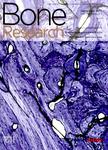Hypoxia-inducible factor-1a restricts the anabolic actions of parathyroid hormone
Hypoxia-inducible factor-1a restricts the anabolic actions of parathyroid hormone作者机构:Department of Orthopaedic Surgery Johns Hopkins University School of Medicine Division of Nephrology Bone & Mineral Metabolism University of Kentucky Veterans Administration Medical Center
出 版 物:《Bone Research》 (骨研究(英文版))
年 卷 期:2014年第2卷第1期
页 面:33-42页
学科分类:1001[医学-基础医学(可授医学、理学学位)] 10[医学]
基 金:Support was provided by a Career Development Award (RCR BX001284) from the Veterans Administration
主 题:PTH Hypoxia-inducible factor-1a restricts the anabolic actions of parathyroid hormone Figure
摘 要:The hypoxia inducible factors (Hifs) are evolutionarily conserved transcriptional factors that control homeostatic responses to low oxygen. In developing bone, Hif-1 generated signals induce angiogenesis necessary for osteoblast specification, but in mature bone, loss of Hif-1 in osteoblasts resulted in a more rapid accumulation of bone. These findings suggested that Hif-1 exerts distinct developmental functions and acts as a negative regulator of bone formation. To investigate the function of Hif-1a in osteoanabolic signaling, we assessed the effect of Hif-1a loss-of-function on bone formation in response to intermittent parathyroid hormone (PTH). Mice lacking Hif-1a in osteoblasts and osteocytes form more bone in response to PTH, likely through a larger increase in osteoblast activity and increased sensitivity to the hormone. Consistent with this effect, exposure of primary mouse osteoblasts to PTH resulted in the rapid induction of Hif-1a protein levels via a post-transcriptional mechanism. The enhanced anabolic response appears to result from the removal of Hif-1a-mediated suppression of β-catenin transcriptional activity. Together, these data indicate that Hif-1a functions in the mature skeleton to restrict osteoanabolic signaling. The availability of pharmacological agents that reduce Hif-1a function suggests the value in further exploration of this pathway to optimize the therapeutic benefits of PTH.



